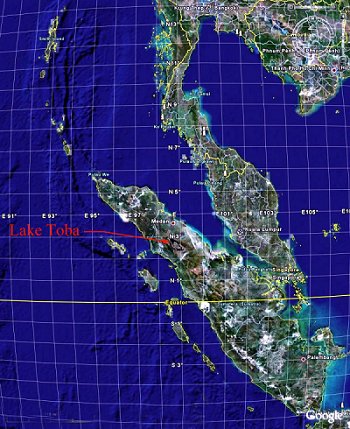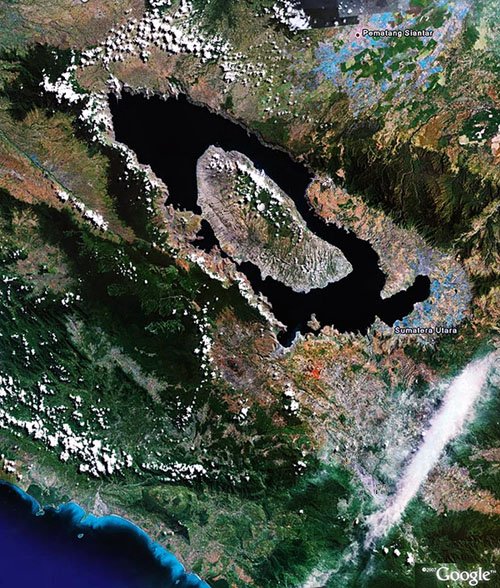A Big Volcano
Today, a very big volcano. The University of Houston's College of Engineering presents this series about the machines that make our civilization run, and the people whose ingenuity created them.
The worst volcanic eruption in the past two million years took place in northwest Sumatra, 74,000 years ago. When Mount Toba blew, it spewed out ten billion tons of ash, and left a huge hole in the ground. Today, that hole is Lake Toba -- fifty-five miles long, twenty miles wide, and over 1600 feet deep. At the center is Samosir Island -- a lovely tourist spot and the largest island-within-an-island in the world.
 One might think a volcanic eruption, so long ago, was rather like the philosophical tree falling in the philosophical forest. But it was not. The Toba eruption was the worst disaster the human race experienced -- even ahead of the 14th-century Plague.
One might think a volcanic eruption, so long ago, was rather like the philosophical tree falling in the philosophical forest. But it was not. The Toba eruption was the worst disaster the human race experienced -- even ahead of the 14th-century Plague.
Genetic anthropologist Stephen Oppenheimer is pretty certain that we modern humans began an emigration from East Central Africa about 85,000 years ago. By the time Mount Toba blew, we were across India, down the Malay Peninsula, into Sumatra and Java, across into Borneo, and up through Indochina into most of the China coast.
Then Mount Toba spewed two-thousand times as much ash as Mount St. Helens did. Ash covered all of India to a depth of at least a half foot, and to a depth over twenty feet in some places. But the entire world was devastated by the atmospheric ash. The result was a six-year "nuclear winter" followed by a thousand-year ice-age. The entire human species was devastated, and it was completely exterminated between Java and the present-day border of Iran.
When human survivors finally recovered, they renewed their migrations. The now-separate Southeast Asian branch of humans spread down into northern Australia, eastward across New Guinea, as well as back toward India once again. The two human branches finally rejoined around India's southern tip.
These human migrations have been pieced together from limited information. Dating has been difficult, and human remains few, after so long a time. But the volcanic ash below the surface of the Kota Tampan area in central Malaysia has yielded fifty thousand or so stone artifacts made by the people smothered under the ashes.
Those tools were more primitive than African implements from that time. These people were still making so-called pebble tools, small stones shaped into elementary choppers, scrapers, and hand axes. However, the few survivors on the other side of Malaysia were the adventurers who continued into Australia and China.
What I take away from all this is a reminder of how vast time and nature are. At the end of February, 2007, the Horizons spacecraft passed Jupiter's moon Io. It sent back a photo of a huge volcano shooting debris two hundred miles above the surface.
That should be a poignant reminder that the inexorable immensity of nature is a wolf lingering close by our doors today, just as surely as she did 74,000 years ago.
I'm John Lienhard, at the University of Houston, where we're interested in the way inventive minds work.
For more on the migrations of modern humans out of Africa, see Stephen Oppenheim's site.
For more on Mount Toba, Lake Toba, and the Io eruption, see the Wikipedia article on LakeToba

Lake Toba (Images courtesy of Google Earth)